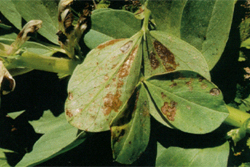Chocolate spot of faba bean
Chocolate spot is the most important disease of faba beans in Victoria and South Australia.

The disease can be managed through an integrated approach including careful paddock selection, the use of resistant varieties and strategic use of foliar fungicides.
What to look for
Symptoms are varied and range from small spots on the leaves to complete blackening of the entire plant. Leaves are the main part of the plant affected but under favourable conditions for the disease it also spreads to stems, flowers and pods.
Two stages of the disease are usually recognised. First, a non-aggressive phase, when discrete reddish-brown spots are 'peppered' over the leaves and stems and then an aggressive phase, when spots darken in colour and coalesce to form larger grey-brown target spots that may eventually cover the entire plant. Small black sclerotia may sometimes be found inside the stems of badly diseased plants.
Severe pod infection can cause pod splitting and seed discolouration. Small black sclerotia may sometimes be found inside the stems of badly diseased plants.

Sometimes, red-legged earth mite damage can be mistaken for chocolate spot. This starts as silvery patches that become red-brown (similar in colour to chocolate spot) but form large irregularly-shaped areas. Red-legged earth mite damage usually occurs during the seedling stage and on the lower leaves.
Disease cycle
Chocolate spot, caused by Botrytis fabae and Botrytis cinerea, can survive either as sclerotia in the soil or on crop debris, in infected seed, or on self-sown volunteer plants. In previously unaffected areas the disease often becomes established by the sowing of infected seed.

In subsequent years, the initial infection usually occurs when spores formed on old bean trash are carried by wind into new crops. These spores may move long distances. Once the disease becomes established it rapidly spreads within a crop, and within 4-5 days of infection spores can be formed on infected tissue and initiate secondary spread of the disease.
Environmental conditions usually determine the severity of a chocolate spot epidemic. The fungus is most aggressive under cool, humid conditions, particularly at flowering time. Aggressive development of stem infection late in the season can cause the crop to lodge.
The optimum conditions are temperatures between 15 and 22°C with at least 90 per cent relative humidity. However, infection will develop slowly at lower temperatures.
Significant yield reductions can result from infection of flowers, which causes them to abort without forming pods.
Economic importance
Chocolate spot occurs in all areas where faba beans are grown, causing losses ranging from minor to complete failure of a crop. Loss depends on the severity of infection, the time at which infection occurred, and the amount of spring rainfall.
In unprotected crops, the disease can reduce yields by 30–50 per cent under conditions favourable for disease development. In addition, seed from badly affected plants may have a reddish-brown discolouration, which lowers its market value.
Management
An integrated approach is the key to successful management of chocolate spot blight in faba bean. Foliar sprays provide excellent disease control even in susceptible varieties but must be applied before rain or wet periods to be effective.
Variety
Select the variety with the highest level of resistance to the important disease risk in your district. See the Victorian Pulse Disease Guide for more information on resistant varieties.
Seeding
Aim to use the 'cleanest' seed possible with less than 10 per cent, preferably zero, seed infection with Botrytis.
Seed should be sourced from the 'cleanest' crops. Old, frosted or damaged seed may have reduced germination and reduced vigour.
Follow the recommended sowing rates for your district, and remember that sowing rates may vary between varieties.
Seed treatment
Treat all seed with a seed dressing registered for chocolate spot control.
Paddock selection
A break of at least 4 years should be observed between faba bean crops.
Aim to separate this year's faba bean crop from last year's faba bean stubble by a distance of 500m.
Minimise the disease risk by not sowing adjacent to vetch, chickpea or lentil stubble as they are alternate hosts for Botrytis.
Foliar fungicides
In areas of high risk it may be necessary to apply foliar fungicides to protect the crop, especially if a susceptible variety is being grown. To be effective, fungicides must be applied at the first sign of disease. If conditions remain conducive for disease (warm and wet) follow up sprays may be necessary 12 to 14 days later.
See the Australian Pulse Bulletin Pulse Seed Treatments and Foliar Fungicides for more information on foliar sprays.
Harvest
Plan to harvest as early as possible to minimise disease infection on seed.
Further references
- Pulse Australia
- Faba Bean Souther Region – GrowNotes
- Winter Pulse Disorders: The Ute Guide
- Pulse Seed Treatments and Foliar Fungicides
- Seed Health Testing in Pulse Crops
Contact
Dr Joshua Fanning
Pulse Pathologist – Horsham
0419 272 075
Field Crops Pathology
Grains Innovation Park
110 Natimuk Rd
Horsham 3400
03 5450 8301
Or call the Customer Service Centre, 136 186
Acknowledgements
Helen Richardson and Trevor Bretag, Horsham and Luise Sigel, Agriculture Victoria, Horsham. Support by the Grains Development and Research Corporation is gratefully acknowledged.